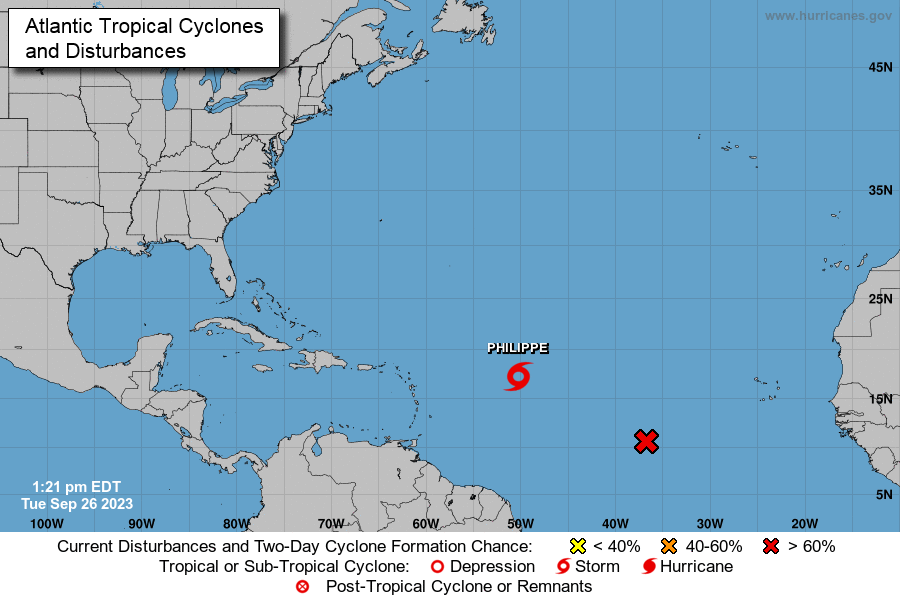National Hurricane Center tracking Tropical Storm Philippe; Ophelia weakens, soaks Northeast
Post-tropical Cyclone Ophelia continued to bring coastal flooding to portions of Chesapeake Bay and heavy rainfall from Ophelia may produce localized flash and urban flooding across from Virginia to New Jersey through Sunday, according to the National Hurricane Center.
A gradual weakening is forecast during the next 48 hours as it slowly moves offshore.
On Saturday, Philippe became the 16th named storm of the 2023 Atlantic hurricane season.
As of 11 a.m. Sunday, the storm was located 1,175 miles west of the Cabo Verde Islands, moving west at 12 mph with maximum sustained winds of 50 mph, the National Hurricane Center said in its latest update.
Little change in intensity is forecast over the next couple of days and the storm is currently expected to move more west-northwestward and northwestward by the middle of the week, the NHC said.
Here's the latest update from the NHC as of 11 a.m.:
Tropical Storm Philippe
Location: 1,175 miles west of Cabo Verde Islands
Maximum wind speed: 50 mph
Direction: West at 12 mph
➤ Track Tropical Storm Phillippe:
What's out there and where are they?
Tropical Storm Philippe is located about 1,175 miles west of the Cabo Verde Islands, moving west at 12 mph with maximum sustained winds of 50 mph, according to the NHC.
Tropical wave: A small area of low pressure with disorganized shower activity has formed several hundred miles south of the Cabo Verde Islands.
How likely are they to strengthen?
Tropical Storm Philippe is expected to strengthen and could become a hurricane, the NHC said. A move west-northwestward and northwestward by the middle of the week is expected and little change in intensity is forecast over the next couple of days
Tropical wave: Environmental conditions are forecast to be conducive for gradual development, and a tropical depression could form around midweek while the system moves westward to west-northwestward across the central tropical Atlantic, NHC said.
Formation chance through 48 hours: 10 percent.
Formation chance through seven days: 40 percent.
Who is likely to be impacted?
Post-tropical Cyclone Ophelia is expected to bring coastal flooding to portions of Chesapeake Bay and heavy rainfall from Ophelia may produce localized flash and urban flooding across from Virginia to New Jersey through Sunday.
It's too early at this time to determine if there will be any impact to the U.S. from Tropical Storm Philippe or the tropical wave.
Forecasters urge all residents to continue monitoring the tropics and to always be prepared.
What is coral bleaching? Here's how an unprecedented ocean heat wave causes changes below
Weather watches and warnings issued in Florida
When is the Atlantic hurricane season?
The Atlantic hurricane season runs from June 1 through Nov. 30.
When is the peak of hurricane season?

The peak of the season is Sept. 10, with the most activity happening between mid-August and mid-October, according to the Hurricane Center.
Tropical forecast over the next seven days
Excessive rainfall forecast
What's out there?
Systems currently being monitored by the National Hurricane Center.

What's next?
We will continue to update our tropical weather coverage daily. Download your local site's app to ensure you're always connected to the news. And look at our special subscription offers here.
This article originally appeared on Fort Myers News-Press: NHC tracking Tropical Storm Philippe and new system

